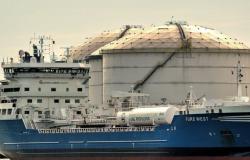Currently, the most commonly found fish in the Baltic Sea are: quail, halibut and starling. According to experts, slowing down the process of extinction of others or bringing back those that have disappeared can only be done by breeding them or reducing their consumption.
Marijus Spegys, Antanas Kontautas, Remigijus Sakas and Tomas Zolubas Delfi, junior researchers of Klaipėda University’s Marine Research Institute, presented the latest information on the Baltic Sea fish population, pollution and suitability for consumption.
It can be used, but in moderation
Since the Baltic Sea is surrounded by many countries, various economic activities are carried out, and considerable amounts of pollutants accumulate in it. If substances such as nitrogen and phosphorus are not harmful to the human body, then heavy metals, especially dioxins and polychlorinated biphenyls, are quite dangerous. It is their amount in the environment that determines the food suitability of fish.
“Dioxins are chemical compounds found in the natural environment that include 75 polychlorinated dibenzo-p-dioxins (PCDDs) and 135 related polychlorinated dibenzofurans (PCDFs). Of these, 17 are toxic. Dioxins are produced as by-products, usually during various combustion processes. Polychlorinated biphenyls can also be found in the sea and may or may not be toxic. PCBs are produced and used as transformer oil, as well as in various electronic devices,” explained A. Kontautas.
Dioxins and polychlorinated biphenyls are fat-soluble, very persistent, difficult to break down compounds, so they accumulate in the fatty tissue of animals and humans and can persist for a very long time. Their toxic properties can have a negative effect on human health: promoting the appearance of cancer cells, damage to the nervous system, etc. For example, in Sweden, it is suggested not to eat Baltic Sea fish for children under 14, nursing mothers and pregnant women. And adults of working age are recommended to eat fish caught in the Baltic Sea no more than once a week.
Lithuanian State Food and Veterinary Service (VMVT) since 2004. conducts annual tests on dioxins and PCBs in fish caught in the Baltic Sea intended for human consumption.
“In order to protect the health of consumers, in 2011 The State Food and Veterinary Service has banned food processing entities from supplying Baltic cod livers caught in the Baltic Sea for human consumption and animal feeding (except for fur-bearing animals) due to consistently high concentrations of dioxins and PCBs. So, it is possible to eat what is not prohibited and in compliance with the norms recommended by the services responsible for food safety,” said the scientist.
Fishing rates vary due to many factors
According to Saulius Mikalauskas, president of the Lithuanian Anglers’ Union, over the past 5-10 years, fishing in the Baltic Sea has deteriorated significantly, and the main reason for this is commercial fishing.
According to scientists, it is impossible to briefly describe the fishiness of the Baltic Sea, a more accurate term would be the state of the Baltic Sea fish resources. “Our researchers catch more than 40 species of fish on the coast of the Baltic Sea, and the situation with each species is different. I can give more detailed information about several species of fish which are, or have recently been, an important object of commercial fishing and excite the greatest passions of the public. It should also be said that our research covers only 3% of the Baltic Sea’s water area, so the state of resources is assessed based on the data provided by all EU member states”, explained R. Sakas.
Until 2020, cod was the main object of fishing in the open Baltic Sea. Most of the cod caught by our vessels was landed in Klaipėda and allowed the local economy to generate added value. Cod was an important object of recreational fishing in the Baltic Sea. Unfortunately, due to various reasons, such as over-fertilization of the Baltic Sea, climate change, some parasites, cod stocks have reached a critically bad level.
“Due to the ban on cod fishing, our fleet is practically no longer able to catch flounder either, although their resources are in a stable state. For this reason, from 2022, no ship fishing in the open Baltic Sea will enter the port of Klaipėda, so all the fish caught by our ships in the open Baltic Sea enters the market of other countries. We only have fish caught on the Baltic coast,” said R. Sakas about the cod population.
Mr. Spegys added that one of the important factors depleting cod is parasites spread by seals. With an extremely large population of gray seals in the Baltic Sea, cod infestation had reached unprecedented levels. in 2021 even 66 percent these fish were infected. “Recently, the parasitological situation has improved. At the beginning of this year, our research showed that infection with liver parasites decreased to 32%, which gives us hope that healthier cod will be able to breed more successfully,” said the junior researcher about the parasites.
Bretlings, also called sprats, which are so loved by Lithuanians, have recently been mostly fished by our ships in the open Baltic Sea. They are caught from 10 to 16 thousand tons per year. Unfortunately, recently all Bretlings are unloaded in foreign ports, which generates minimal added value for the Lithuanian economy. The resources of Bretlingiai are in a fairly good condition, the influence of Lithuanian fishermen on their condition is also minimal – only 5% of the quota set for EU countries is allocated to Lithuania. In the long term, the breetling fishery may be more limited due to the co-catch of a number of stripers, the stocks of which are last assessed to be in poor condition.
Sandfish fishing traditionally receives a great deal of attention from the Lithuanian public. Their fishing is not regulated by EU legislation, so the International Maritime Research Council (IMC) does not assess these fish stocks. Most pike in the Baltic Sea are caught by Finnish and Latvian fishermen, but recently the catches of the Latvian brothers have also decreased drastically. Stingrays like the cold, so according to experts, it is likely that they moved to the northern part of the Baltic Sea due to climate warming.
Stingrays spawn in fresh waters, unfortunately, from 2021, sturgeons are practically not caught in the Nemunas delta of Lithuania. “Our research shows that the migration of sturgeons to the Curonian Lagoon fluctuates significantly. In 2022, there were a lot of pike fry on the Baltic coast, and last year a lot was also found in the stomachs of predatory fish, so let’s hope that there will be a lot of Lithuanian pike during the 2025-2026 pike festivals in Palanga. However, the fact that pike are no longer caught in the Lithuanian Nemunas delta is worrying. We cannot clearly determine the reasons yet, one of them may be a change in the hydrological situation in the Nemunas delta due to the dredging of the delta carried out on the Russian side,” said R. Sakas.
Some species are disappearing, others are recovering
in 2019 scientists found that cod stocks in the eastern Baltic Sea are in a worse condition than previously expected, prompting urgent action as these fish stocks have been below safe biological limits for several years. Scientists recommend stopping all cod fishing, including amateur fishing. This is also consistent with the plan, which provides that when stocks are below safe biological limits, additional measures must be taken to rectify the situation as quickly as possible.

EU countries have banned specialized cod fishing in order to protect cod stocks, while the Russian Federation has not. in 2020 The Russian Federation caught 1,778 tons in 2021. – 1225 t of cod, which accounted for 77% and 88% of the total catch in the Baltic Sea.
It was found that their low growth rate, entanglement, and high natural mortality are related to changes in the ecosystem: poor oxygen conditions caused by climate change, a decrease in the amount of fish food in the main distribution area of cod, and parasites.
Last year, the ICJ recommended zero catches of cod and that measures to protect cod should be assessed in the context of climate change and the cumulative anthropogenic impact of a degrading ecosystem. Another factor that can have an impact is the reduction of eutrophication. It would increase the amount of oxygen in the bottom layer and restore cod habitats. For this, all the countries surrounding the Baltic Sea should significantly reduce the amount of nitrogen and phosphorus entering the sea. These substances enter the rivers during intensive agriculture when fertilizing the fields.
“Although, so far, the state of the resource has not responded to conservation measures, two important aspects need to be understood. First of all, it takes time for the impact to manifest, and secondly, you need to keep in mind geopolitical and ecosystem factors that limit the possibilities of resource recovery,” said T. Zolubas.
Mice. In the first half of the last century, quail was one of the most common fish caught in the Curonian Lagoon. Until 1998 The quail was classified as a species of the Lithuanian Red Book, category 1 E (a species on the verge of extinction), and in 2005 was removed from the list of endangered species altogether.
“For several years, our observations have shown an increase in the frequency and abundance of quail chicks, so their large catches in 2023 was a very likely and expected result. in 2022 10 tons were caught, and in 2023 – almost 40 t on the coast and in the Curonian Lagoon. It is known that quails are sensitive to water pollution, so stopping Grigeo’s pollution into the Curonian Lagoon could also have been one of the factors that led to the recovery of quail resources in a few years,” noted the KU junior researcher.
He urges not to blame the business
Recently, there has been a lot of discussion about commercial fishing in the Baltic Sea. Critics claim that it destroys or displaces species, supporters draw the card of benefits for the economy and claim that Lithuania’s quotas are too small to determine the extinction of species in addition to other factors. The president of the Lithuanian Anglers’ Union is convinced that the business significantly contributes to the decrease in fish availability: “We believe that there should be no commercial fishing up to 500 m from the shore, because spawning or spawning migrating fish are mostly caught here. Significant restrictions or total bans on commercial fishing should be introduced. Protection of fish during their spawning in spawning grounds and during migration to spawning grounds should also be applied.”

According to R. Sako, commercial fishing was one of the factors that led to the collapse of cod stocks, but Lithuania is allocated only 5.5% of the quota set for the countries of the European Union, the catches in 2000-2019 amounted to 4-6 percent of the catches of all EU countries, so the influence of Lithuanian fishermen the state of the cod stock was insignificant, and the influence of the fishermen of the Baltic coast can be compared to a “drop in the sea”.
He believes that it is not possible to blame Lithuanian fishermen for overfishing herrings. Lithuania has only 2.9% of the central Baltic herring quotas. Finland, Sweden, Estonia and Latvia catch the most of them. Studies show that flounder resources in the coastal waters of the Baltic Sea are in a stable state, and in the southern part, they are even improving. Also recently, the condition of quail stocks, which were close to extinction a few years ago, has improved significantly.
“You really can’t blame our fishermen for the state of resources in the Baltic Sea, it must be replaced by recreational fishing. However, such fishing is not carried out in the Baltic Sea, except from the Palanga bridge. Those who want to ban commercial fishing on the Baltic coast are not recreational fishermen, but representatives of the recreational fishing business. Their “concern” about the impact of Lithuanian commercial fishing on fish resources is just a smokescreen. In fact, this is a “war” over the territory needed for the recreational fishing business, not over resources,” R. Sakas said.









